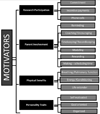Parent and child perceptions of a self-regulated, home-based exercise program for children with cystic fibrosis
- PMID: 23995464
- PMCID: PMC4053557
- DOI: 10.1097/NNR.0b013e3182a03503
Parent and child perceptions of a self-regulated, home-based exercise program for children with cystic fibrosis
Erratum in
- Nurs Res. 2014 Jan-Feb;63(1):25. DiVirgilio, Dana [corrected to Divirgilio, Dana]
Abstract
Background: Despite recognized benefits, many children with cystic fibrosis (CF) do not consistently participate in physical activities. There is little empirical literature regarding the feelings and attitudes of children with CF toward exercise programs, parental roles in exercise, or factors influencing exercise experiences during research participation.
Objectives: The aim of this study is to describe the exercise experiences of children with CF and their parents during participation in a 6-month program of self-regulated, home-based exercise.
Methods: This qualitative descriptive study was nested within a randomized controlled trial of a self-regulated, home-based exercise program and used serial semistructured interviews conducted individually at 2 and 6 months with 11 purposively selected children with CF and their parent(s).
Results: Six boys and five girls, ages 10-16 years, and parents(nine mothers, four fathers) participated in a total of 44 interviews. Five major thematic categories describing child and parent perceptions and experience of the bicycle exercise program were identified in the transcripts: (a) motivators, (b) barriers, (c) effort/work, (d) exercise routine, and (e) sustaining exercise. Research participation, parent-family participation, health benefits, and the child's personality traits were the primary motivators. Competing activities, priorities, and responsibilities were the major barriers in implementing the exercise program as prescribed. Motivation waned, and the novelty wore off for several (approximately half) parent-child dyads, who planned to decrease or stop the exercise program after the study ended.
Discussion: We identified motivators and barriers to a self-regulated, home-based exercise program for children with CF that can be addressed in planning future exercise interventions to maximize the health benefits for children with CF and the feasibility and acceptability to the children and their families.
Conflict of interest statement
The authors have no conflicts of interest to report.
Figures
References
-
- Adeniyi FB, Young T. Weight loss interventions for chronic asthma. Cochrane Database of Systematic Reviews. 2012;7:CD009339. - PubMed
-
- Broome ME, Richards DJ. The influence of relationships on children's and adolescents' participation in research. Nursing Research. 2003;52:191–197. - PubMed
-
- Bucks RS, Hawkins K, Skinner TC, Horn S, Seddon P, Horne R. Adherence to treatment in adolescents with cystic fibrosis: The role of illness perceptions and treatment beliefs. Journal of Pediatric Psychology. 2009;34:893–902. - PubMed
-
- Cholewa JM, Paolone VJ. Influence of exercise on airway epithelia in cystic fibrosis: A review. Medicine in Science in Sports and Exercise. 2012;44:1219–1226. - PubMed
Publication types
MeSH terms
Grants and funding
LinkOut - more resources
Full Text Sources
Other Literature Sources
Medical


